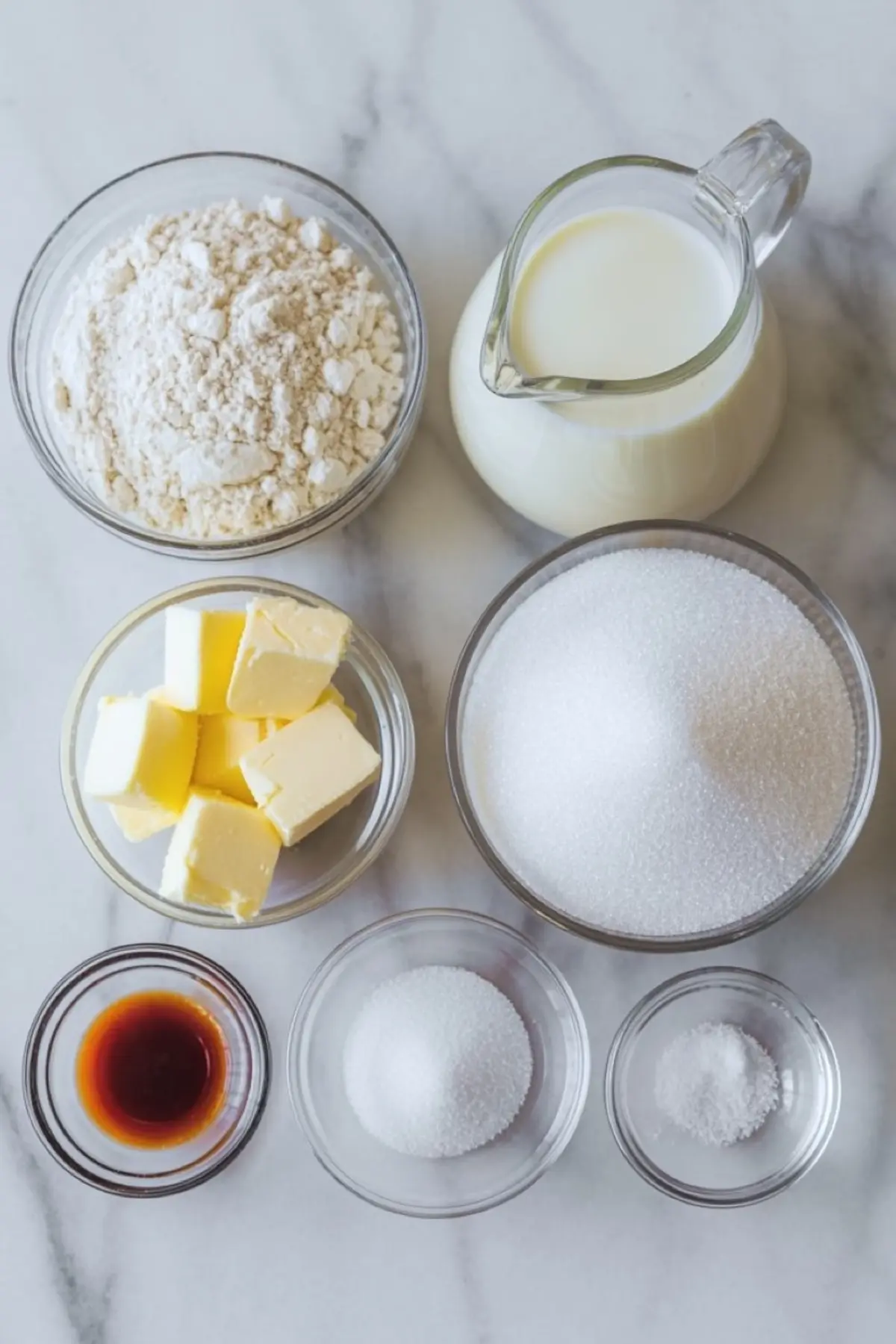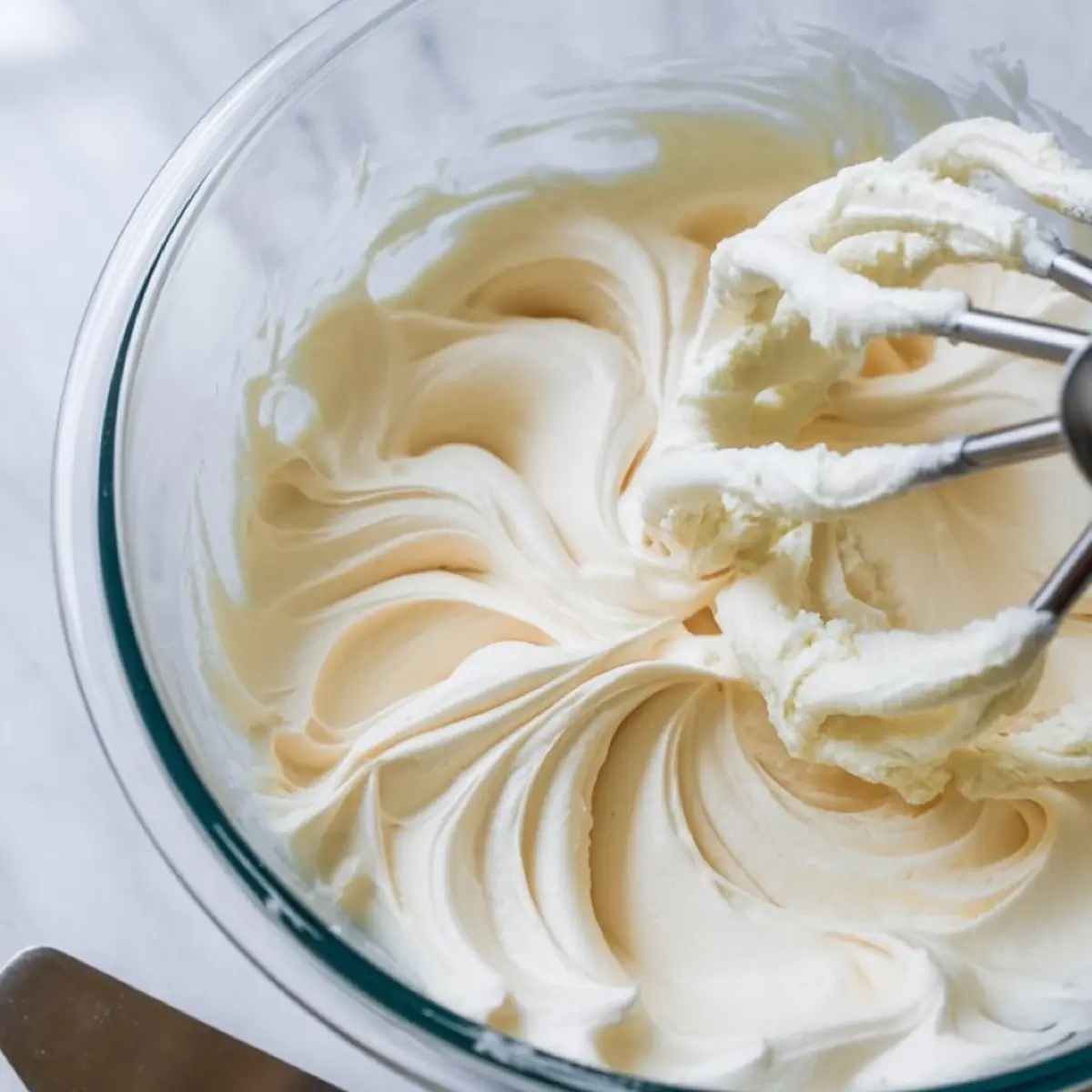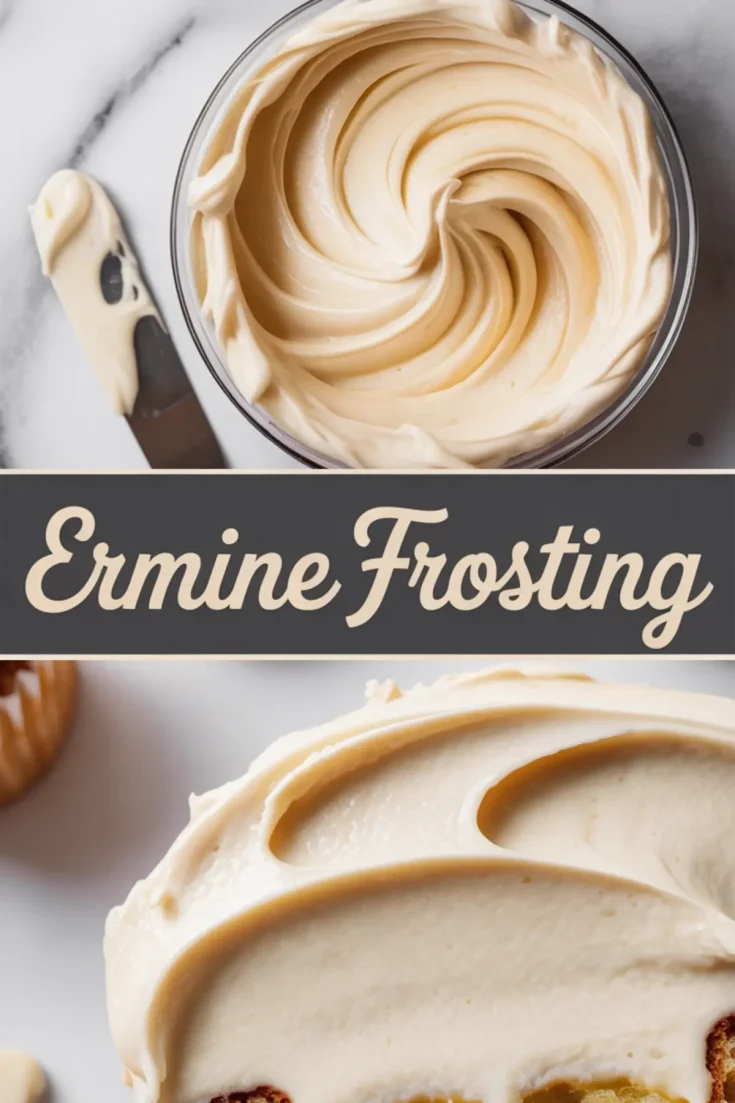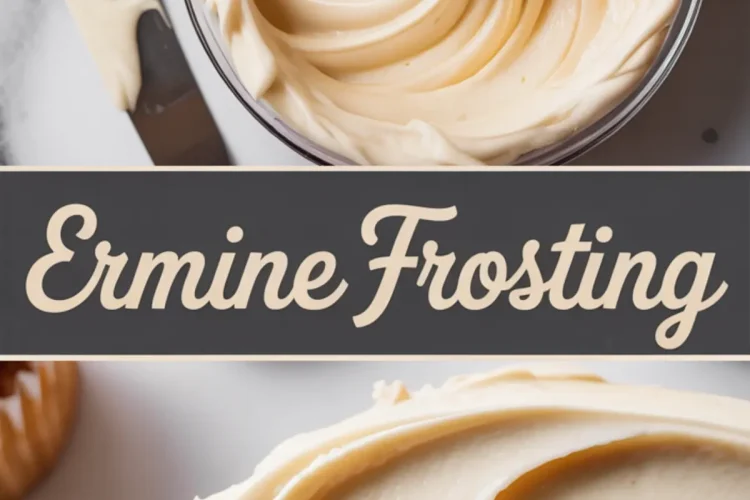Ermine frosting, also known as boiled milk frosting, quietly earns its place in your kitchen. It isn’t flashy. It doesn’t shout. But it has a texture that whispers quality and a flavor that doesn’t overpower the cake beneath it.
This recipe gives you a frosting that tastes like something between whipped cream and buttercream but behaves more predictably than both. You’ll learn how to cook a flour-milk roux, whip it with butter and sugar, and end up with a smooth, pipeable frosting that keeps its shape even on a warm day. That alone makes it one of the most dependable frosting recipes easy enough for beginners, yet reliable enough for professionals.
Unlike classic American buttercream, ermine frosting isn’t overly sweet. It’s light, but with structure. Silky, but not greasy. The flavor carries vanilla in a way that feels composed. It holds up on cupcakes and slices cleanly through layer cakes without dragging. I turn to this when I want homemade frosting that doesn’t fight with the cake, especially for red velvet, sponge cakes, or vintage-style bakes where balance matters more than flash.
Let’s get into how to make it, what makes it work, and how to use it so you can build confidence and consistency every time you frost.

Ingredients for Silky, Fluffy Ermine Buttercream
Start with flour, milk, sugar, butter, and vanilla. That’s all it takes. You’re essentially making a pudding, or roux base, and blending it with butter and sugar until you create a cloudlike frosting.

I’ve tested this with both whole milk and 2%. Whole milk gives a smoother, richer result. The butter must be soft but not melted, or the emulsion will break. If you’re short on time, place the butter on a warm plate for 20 minutes while the roux cools.
This frosting relies on precision. It’s not difficult, but it does ask for your attention.
Making the Roux: The Heart of This Icing Frosting

Whisk the flour and milk in a saucepan until smooth before turning on the heat. If you start with lumps, they’ll follow you through the entire batch. Keep the whisk moving once the heat goes on. It only takes about seven minutes for the mixture to thicken into a pudding-like texture.
You’ll know it’s ready when it no longer runs from the spoon, but mounds gently. Thick, but still glossy. At this stage, you must cool it completely. If it’s even slightly warm when added to the butter, the frosting can split. I’ve tried shortcuts. They don’t work.
Cover the surface with plastic wrap to prevent a skin, then cool at room temperature or refrigerate for 30 minutes. That extra step is what transforms this into a fluffy frosting that holds its shape.
You can also explore other base techniques like the one I use in this vanilla buttercream frosting, which skips the roux for a more direct method.
Creaming Butter and Sugar: Be Patient Here

In this step, you’re not just mixing you’re aerating. The butter and sugar need about five minutes at medium-high speed to truly lighten. Some granularity may remain. That’s fine. It will smooth out once the roux gets incorporated.
Don’t cut this step short. It’s what gives the ermine buttercream recipe its loft and makes it feel like a cross between frosting and whipped cream.
I’ve seen bakers try to swap granulated sugar with powdered, thinking it might dissolve faster. It doesn’t. Stick to granulated. The frosting relies on the slow blending to create structure, not shortcuts.
Roux Meets Butter: Add It Slowly and Watch It Transform
Once the roux is cold, add it to the butter mixture one tablespoon at a time. Go slow. Let each spoonful fully incorporate before adding the next. This is the point where the frosting can start to look loose before it tightens. Keep going.
By the final addition, the frosting should look smooth, slightly glossy, and firm enough to pipe. Not dense, but not runny either. It holds swirls on cupcakes, which you’ll notice right away if you use it as a cupcake frosting.
If you’re curious how this stacks up against whipped frostings, I have a full recipe for whipped cream frosting that compares well in lightness, though it lacks the structure of ermine.
Vanilla, Salt, and Final Mixing: Finish It With Care
Add the vanilla and a pinch of salt at the end, then mix just until blended. That salt does more than season. It balances the sweetness and brings the butter flavor forward.
From here, your frosting is ready to use. I usually test a spoonful on parchment to check how it pipes. It should hold shape but still feel smooth when you spread it. If you’ve cooled everything properly and mixed slowly, this step should feel simple.
You can also try variations with flavored extracts. Maple extract adds a warm edge, especially during fall bakes. You might enjoy this maple frosting if you’re looking to branch out once you’ve mastered ermine.
Comparison: Roux-Based Ermine vs Cool Whip Cream Cheese Frosting
I’ve worked with both, especially when planning ahead for events. Here’s what stands out.
Ermine frosting has more structure and a clean vanilla flavor. It pipes better and holds on warm days. It also suits layer cakes where stability matters. In contrast, the Cool Whip cream cheese frosting is lighter and more tangy. It’s great for quick cakes or no-bake desserts.
If I’m frosting a wedding-style vanilla cake or red velvet, I go with ermine. If I’m doing a tray of sugar cookie bars, I reach for the Cool Whip version.
How to Store and Use This Homemade Frosting
Use it the same day for best results. If you need to store it, keep it covered in the fridge for up to three days. Bring it back to room temperature and re-whip before spreading. The texture may firm up, but it will loosen as you mix.
Ermine makes a dependable cake filling too. You can spread it between layers, chill the cake slightly, then crumb-coat for a clean finish. If you’re decorating cookies, try the sugar cookie frosting recipe instead, which dries with a soft crust.
I’ve even used ermine as a base for piping roses. It holds up better than you’d expect for something so smooth.
Final Thoughts and Tips – Save This to Your Frosting Board

Ermine frosting fits somewhere between nostalgic and professional. It reminds me of the kind of frosting my grandmother used, back when butter was softened on the windowsill and everything was whisked by hand.
Once you get a feel for the timing and texture, you won’t need to look up the steps again. You’ll just know. If that’s not the mark of a good cake frosting recipe, I don’t know what is.
Save this post to your Pinterest frosting board so you can find it again when you need something soft, pipeable, and just sweet enough.
And if you try it, tell me how it turned out in the comments. Did you love the texture? Did you adjust the sugar? I’m always curious how it lands in different kitchens.
Ermine Frosting (Boiled Milk Frosting)

Ermine frosting is a light, fluffy frosting that’s made by cooking flour, sugar, and milk into a base, then whipping it with butter until silky smooth. I love how this ermine buttercream recipe is less sweet than classic buttercream, making it perfect for layer cakes, red velvet, or cupcake frosting. Some bakers call it boiled milk icing frosting or vanilla ermine frosting, but either way, it’s one of my favorite homemade frosting methods when I want something stable and creamy. Out of all frosting recipes easy to master, this one delivers a texture that feels like whipped cream but holds up beautifully as a cake frosting recipe or filling. Once you try ermine buttercream, it quickly becomes the go-to for bakes that need both flavor and structure.
Ingredients
- 5 tablespoons all-purpose flour
- 1 cup whole milk
- 1 cup unsalted butter, softened
- 1 cup granulated sugar
- 1 tablespoon vanilla extract
- Pinch of salt
Instructions
- MAKE THE ROUX: In a small saucepan, whisk together the flour and milk until completely smooth. Place over medium heat and cook, whisking constantly, for 5 to 7 minutes or until the mixture thickens to a pudding-like consistency.
- COOL THE ROUX: Remove the thickened mixture from heat. Transfer to a shallow bowl and cover the surface directly with plastic wrap to prevent a skin from forming. Let it cool completely at room temperature or in the refrigerator for about 30 minutes.
- BEAT THE BUTTER AND SUGAR: In a stand mixer fitted with a paddle attachment or using a handheld mixer, beat the softened butter and granulated sugar together on medium-high speed for about 5 minutes or until light and fluffy. The sugar should start to dissolve, though some graininess is normal at this stage.
- ADD THE ROUX TO THE BUTTER MIXTURE: Add the cooled roux to the butter mixture one tablespoon at a time, beating well after each addition. Continue until all the roux is incorporated and the mixture looks light and airy.
- FINISH THE FROSTING: Add the vanilla extract and a pinch of salt. Beat again just until fully blended. The finished frosting should appear smooth, glossy, and hold its shape when piped.
Notes
Make sure the roux is completely cool before adding it to the butter, or the frosting may separate. This frosting is best used the day it is made but can be stored in the refrigerator for up to 3 days. Re-whip before using.
Nutrition Information
Yield
1Serving Size
1Amount Per Serving Calories 2730Total Fat 192gSaturated Fat 119gTrans Fat 0gUnsaturated Fat 63gCholesterol 512mgSodium 266mgCarbohydrates 243gFiber 1gSugar 214gProtein 14g


